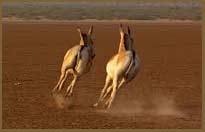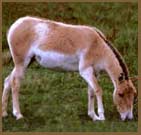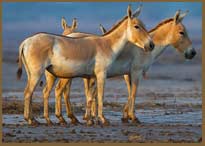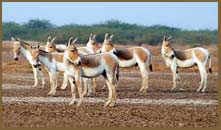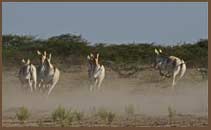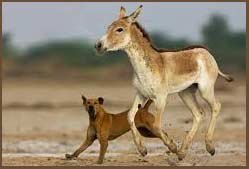Wild Ass
Introduction
Page 1 of 5
Indian Wild Ass called with scientific name as Equus hemionus khur is a rare species of Indian Wildlife.
Its kingdom is Animalia and Phylum being Chordata, belongs to Class Mammalia with the order Perissodactyla. In general it is classified with the Family name as Equidae.
Commonly it is also called with several other names as Indian Wild Ass, Khur, Ghorkhar, or Ghorkad.
Physical Structure
Indian wild ass is quite similar to a horse-like structure. Its coat is sandy in color, it may also change from reddish gray to beige, and to pale chestnut. Mane is dark and also erect and it goes from the back of the head till the neck area. Mane is dark and brown stripes moves with the back of the animal till the end of the tail. Indian wild ass may attain a body length of upto 260 cm and its shoulder has a height of 120 cm range. It has a tail that is quite slim, slender and can gain a length of around 80 cm. It is covered by a brownish and yellow mingled hair.
Indian wild ass has a body weight that is approximately 250 kg in usual. Mouth is slender in shape and ears are long and it is pointed. It is true that it belongs to one among the fastest animals in the World and it can attain the maximum speed of upto 50 km in an hour.
Distribution and Habitat
Indian Wild Asses are genetically adapted to the xerophytes which can be accommodated to the desert regions based on their habitat. Feeding is mostly done by these subspecies in the early morning hours and late in the evening. Copious drinkers, they are quite tolerant of the saline content in their food.
Indian Asses special ability similar to horses is that they are good runners and also have a significant sense of smell as well as hearing. Mostly they are in groups and usually in numbers ranging around ten. Braying is the significant habitual sound from an ass.
Page 2 of 5
Wild Asses use this sound for their communication and a new Ass will be notified when bray sounds more frequently.
Usually the sounds from a wild ass will extend for about twenty seconds.
The strength of wild asses seems to be increasing and extends from Rann of Kutch in the Gujarat state and here is the place at which the world's last population of this species had got confined to in recent years and tends to be moving out and being in line with Greater Rann of Kutch and also extending into the Jalore district which is at the Rajasthan State, bordering the Rann of Kutch in Gujarat. In the interior of Rajasthan the wild asses have started making their presence felt in Khejariali.
In 2007 the forest department in the Rajasthan state has transferred a sixty square kilometers of its neighborhood, by the authorized personnels. Indirect evidences of wild ass were found more during summer compared to post monsoon season.
Wild ass population has gradually increased from less than four hundreds in late sixties to more than four thousand in the twenty first century. Indian wild ass, an equid species inhabits the saline-arid region of the Rann of Kutch in Gujarat.
Indian zoos have currently 12 specimens in two zoos. Analysis of the captive population suggests that the species has negative growth rates and low levels of genetic diversity. The captive population is being sustained because of continued addition of wild founders.
In order to maintain a genetically viable and demographically stable population, a population size of 176 individuals to be achieved over the next 20 years is required. The maintenance of 90 percent genetic diversity over the next 50 years can be achieved by the addition of one founder animal each year for the next 50 years.
Food Habitat
Indian Wild Ass is exclusively a herbivorous animal (Plant Eating Animal) and mainly its feeding is dependent on the coarse grasses that occasionally grow up during the rainy season. Cheek teeth which is large is their advantage and complex folds that enable them to chew the coarse grasses. As it is known that water is scarce in deserts regions, the wild ass intakes most of their daily water from moisture content present in their food.
Mating Behaviour
Page 3 of 5
The general behavior of the Indian wild ass (Equus hemionus khur) shows that breeding is a seasonal activity which occurs
predominantly during monsoon. And during these seasons males depending on their dominance hierarchy protect territories. Those in the higher up of the hierarchy tend to have better habitual conditions in their territories, but subordinate males are relegated to inferior territories.
The females tend to move between territories and select mates with the best territory. Females with young tend to live in small groups of two to five adults.
Places Found
Wild Ass Sanctuary: Wild Ass Sanctuary covers an area of 4953.71 square kilometers of the Little Rann of Kutchh and the Surendranagar district, Rajkot district, Patan district, Banaskantha district and Kachchh district of Gujarat.
It can be easily spotted among big groups in the vast area of deserts along the year and in the entire world. The population of wild ass is the only gene pool of Indian Wild Ass and it is one among the six geographical varieties or sub-species surviving in the world.
Getting into the uniqueness of the area and existence of the rare and endangered species like dalmatian pelican, lesser flamingo, sarus crane, caracal, desert fox, black cobra, etc., their regions are being considered and to be declared as one among the world heritage regions.
This area is recognized internationally, for its natural and geomorphological value, it has high biodiversity conservation significance too. Indian Wild Ass Sanctuary headquarters is Dhrangadhra which is in the district Surndranagar in Gujarat. The sanctuary area extends to about 4953.71 sq. km.
Apart from these places the Wild Asses are also seen in the places around Nal Sarovar at Ahmedabad, which shown a population of over four thousand with a growth of more than four percent.
Threats to Indian Wild Ass
Page 4 of 5
Extreme isolation is another threat and genetic problems can result due to inbreeding.
Extreme grazing by livestock reduces the food availability and also reduces the availability of water at springs. This causes diseases that are stress events and the same is a constant threat to small, isolated Indian Wild Asses. The cutting down of nutritious shrubs and bushes increases the problem still more. In addition to that a series of drought years could have devastating effects on this species.
In India, there is a specific concern resulting in the increase of dense network of roads, railway lines,etc. During the period of 1958-1960, the Indian wild ass became a victim of a disease called as Surra which is due to the Trypanosoma Evansi and they are transmitted by flies resulting in a sudden decline of its species in the Indian sub-continent.
Poaching
The threat affecting the wild ass is poaching for meat and hides. Also in some areas using the rare species for getting traditional medicine is adding to the concern. Persistent threats of poaching, habitat fragmentation and disease outbreaks are causing a rapid decline in their numbers.
It is no wonder then, that these animals are considered a highly endangered and fast disappearing species. Poaching is a major threat which majority of the wild life are facing.
Predators:
Wolves and Hyenas are well known predators for the Indian Wild Asses. The inhospitable areas are places where wild ass thrive and are quite unsuitable for any of the large predators to continue its survival. Above all the wolves and hyenas are well known to prey their young foals. Poaching at an extent turned out to show most of species in the end years of century from their past distribution, till the same was declared as an endangered species.
Conservation Efforts:
Page 5 of 5
Conservation efforts have been made on the Indian wild Ass by the Wildlife Protection organization, and the same organization is trying to bring up the rare species population using different strategies. Owing to the same, one of the key events is the Wild Ass Sanctuary in Rajasthan deserts in the year 1972. This was done based on the Wildlife Protection Act of 1973. This significantly increased the rate of increase in the Asses numbers quite high in the Indian country.
Religion and Mythological View
It was believed that the Ass was a symbol of the Greek god called Dionysus and that was specifically in relationship to Silenius known to be his companion. Asses are called as a measure of wealth in a story of Jacob's Life. Another religious belief prevailing is that the braying of an Ass will nullify the prayer by a human and in the event of crossing of this animal is equal to an devil, this was specified by the Mohammed, the Prophet of Islam. Inversely, we have the Ass portrayed as a vahana (vehicle) of Hindu God Kalaratr, which is called as Gardbha. We also have another belief that the hairs cut from the shoulders of Indian Ass bagged and tied in a child's neck would avoid fits and convulsions, and that the cross for the crucifixion of Jesus Christ was carried by an Ass. As far as the Indian wild Ass is concerned, the endangered species is long way far from all of these unknown beliefs.
Interesting Facts:
• Running at a speed of even greater than 70 to 80 kms an hour, the species itself is categorized as a horse like mammal. One more additional fact is that these Indian Wild Asses can cross a speed of running with Zebras and they can even get closer to the speed of some of the horses.
• They have an appreciable body weight of 250 kilograms and length is about 260 cms.
• They even use their ears for visual communication
• Braying sound is their usual communication with other Asses.


